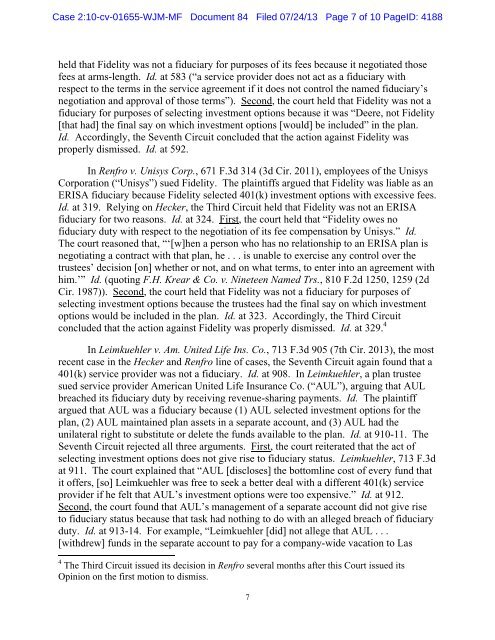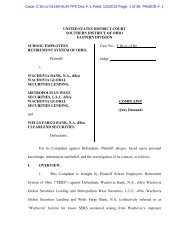Santomenno v. John Hancock Life Ins. Co. - PLANSPONSOR.com
Santomenno v. John Hancock Life Ins. Co. - PLANSPONSOR.com
Santomenno v. John Hancock Life Ins. Co. - PLANSPONSOR.com
Create successful ePaper yourself
Turn your PDF publications into a flip-book with our unique Google optimized e-Paper software.
Case 2:10-cv-01655-WJM-MF Document 84 Filed 07/24/13 Page 7 of 10 PageID: 4188held that Fidelity was not a fiduciary for purposes of its fees because it negotiated thosefees at arms-length. Id. at 583 (“a service provider does not act as a fiduciary withrespect to the terms in the service agreement if it does not control the named fiduciary’snegotiation and approval of those terms”). Second, the court held that Fidelity was not afiduciary for purposes of selecting investment options because it was “Deere, not Fidelity[that had] the final say on which investment options [would] be included” in the plan.Id. Accordingly, the Seventh Circuit concluded that the action against Fidelity wasproperly dismissed. Id. at 592.In Renfro v. Unisys <strong>Co</strong>rp., 671 F.3d 314 (3d Cir. 2011), employees of the Unisys<strong>Co</strong>rporation (“Unisys”) sued Fidelity. The plaintiffs argued that Fidelity was liable as anERISA fiduciary because Fidelity selected 401(k) investment options with excessive fees.Id. at 319. Relying on Hecker, the Third Circuit held that Fidelity was not an ERISAfiduciary for two reasons. Id. at 324. First, the court held that “Fidelity owes nofiduciary duty with respect to the negotiation of its fee <strong>com</strong>pensation by Unisys.” Id.The court reasoned that, “‘[w]hen a person who has no relationship to an ERISA plan isnegotiating a contract with that plan, he . . . is unable to exercise any control over thetrustees’ decision [on] whether or not, and on what terms, to enter into an agreement withhim.’” Id. (quoting F.H. Krear & <strong>Co</strong>. v. Nineteen Named Trs., 810 F.2d 1250, 1259 (2dCir. 1987)). Second, the court held that Fidelity was not a fiduciary for purposes ofselecting investment options because the trustees had the final say on which investmentoptions would be included in the plan. Id. at 323. Accordingly, the Third Circuitconcluded that the action against Fidelity was properly dismissed. Id. at 329. 4In Leimkuehler v. Am. United <strong>Life</strong> <strong>Ins</strong>. <strong>Co</strong>., 713 F.3d 905 (7th Cir. 2013), the mostrecent case in the Hecker and Renfro line of cases, the Seventh Circuit again found that a401(k) service provider was not a fiduciary. Id. at 908. In Leimkuehler, a plan trusteesued service provider American United <strong>Life</strong> <strong>Ins</strong>urance <strong>Co</strong>. (“AUL”), arguing that AULbreached its fiduciary duty by receiving revenue-sharing payments. Id. The plaintiffargued that AUL was a fiduciary because (1) AUL selected investment options for theplan, (2) AUL maintained plan assets in a separate account, and (3) AUL had theunilateral right to substitute or delete the funds available to the plan. Id. at 910-11. TheSeventh Circuit rejected all three arguments. First, the court reiterated that the act ofselecting investment options does not give rise to fiduciary status. Leimkuehler, 713 F.3dat 911. The court explained that “AUL [discloses] the bottomline cost of every fund thatit offers, [so] Leimkuehler was free to seek a better deal with a different 401(k) serviceprovider if he felt that AUL’s investment options were too expensive.” Id. at 912.Second, the court found that AUL’s management of a separate account did not give riseto fiduciary status because that task had nothing to do with an alleged breach of fiduciaryduty. Id. at 913-14. For example, “Leimkuehler [did] not allege that AUL . . .[withdrew] funds in the separate account to pay for a <strong>com</strong>pany-wide vacation to Las4 The Third Circuit issued its decision in Renfro several months after this <strong>Co</strong>urt issued itsOpinion on the first motion to dismiss.7







